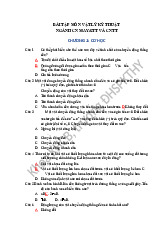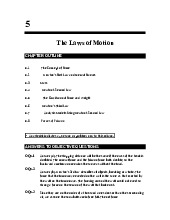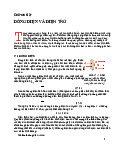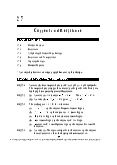



















Preview text:
Embedded Systems SIETK
Unit 5 : Embedded communications protocols and Internet of things
Synchronous/Asynchronous interfaces (like UART, SPI, I2C, USB), serial communication basics,
baud rate concepts, Interfacing digital and analog external device, Implementing and programming
UART, SPI and I2C, SPI interface using TM4C.Case Study: Tiva based embedded system
application using the interface protocols for communication with external devices “Sensor Hub
BoosterPack”. Embedded Networking fundamentals, IoT overview and architecture, Overview of
wireless sensor networks and design examples. Adding Wi-Fi capability to the Microcontroller,
Embedded Wi-Fi, User APIs for Wireless and Networking applications Building IoT applications
using CC3100 user API. Case Study: Tiva based Embedded Networking Application: “Smart Plug
with Remote disconnect and Wi-F c i onnectivity.
Serial Communication basics:
Communication between electronic devices is like communication between humans. Both
sides need to speak the same language. In electronics, these languages are called communication
protocols. Luckily for us, there are only a few communication protocols (SPI,I2C,UART,USB) we
need to know when building most electronics projects.
SPI, I2C, and UART are quite a bit slower than protocols like USB, Ethernet, Bluetooth, and
Wi-Fi, but they’re a lot simpler and use less hardware and system resources. SPI, I2C, and UART are
ideal for communication between microcontrollers and between microcontrollers and sensors where
large amounts of high speed data don’t need to be transferred.
DATA COMMUNICATION TYPES: (1) PARALLEL
(2) SERIAL: (I) ASYNCHRONOUS (II) SYNCHRONOUS Parallel Communication: •
In parallel communication, all the bits of data are transmitted simultaneously on separate communication lines. • Used for shorter distance. •
In order to transmit n bit, n wires or lines are used. • More costly. P a g e | 1 Embedded Systems SIETK •
Faster than serial transmission. •
Data can be transmitted in less time.
Example: printers and hard disk Serial Communication: •
In serial communication the data bits are transmitted serially one by one i.e. bit by bit on single communication line •
It requires only one communication line rather than n lines to transmit data from sender to receiver. •
Thus all the bits of data are transmitted on single lines in serial fashion. • Less costly. • Long distance transmission. Example: Telephone.
Serial communication uses two methods: • Asynchronous. • Synchronous. Asynchronous:
• transfers single byte at a time • No need of clock signal
Example: UART (universal asynchronous receiver transmitter) Synchronous:
• Transfers a block of data (characters) at a time. • Requires clock signal Example:
SPI (serial peripheral interface),
I2C (inter integrated circuit). P a g e | 2 Embedded Systems SIETK
Data Transmission: In data transmission if the data can be transmitted and received, i t is a duplex transmission.
Simplex: Data is transmitted in only one direction i.e. from TX to RX only one TX a nd one RX only
Half duplex: Data is transmitted in two directions but only one way at a time i.e. two TX's, two RX’s and one line
Full duplex: Data is transmitted both ways at the same time i.e. two TX's, two RX’s and two lines
A Protocol is a set of rules agreed by both the sender and receiver on • How the data is packed
• How many bits constitute a character • When the data begins and ends Serial Synchronous Data transfer Type Duplex Protocol /Asynchronous rate (kbps) UART Asynchronous peer-to-peer Full-duplex 20 I2C Synchronous multi-master Half-duplex 3400 SPI Synchronous multi-master Full-duplex >1,000 MICROWIRE Synchronous master/slave Full-duplex > 625 1-WIRE Asynchronous master/slave Half-duplex 16 Baud Rate Concepts:
Data transfer rate in serial communication is measured in terms of bits per second (bps).
This is also called as Baud Rate. Baud Rate and bps can be used inter changeably with respect to UART.
Ex: The total number of bits gets transferred during 10 pages of text, each with 100 × 25
characters with 8 bits per character and 1 start & stop bit is:
For each character a total number of bits are 10. The total number of bits is: 100 × 25 ×
10 = 25,000 bits per page. For 10 pages of data it is required to transmit 2, 50,000 bits. Generally P a g e | 3 Embedded Systems SIETK
baud rates of SCI are 1200, 2400, 4800, 9600, 19,200 etc. To transfer 2, 50,000 bits at a baud rate
of 9600, we need: 250000/9600 = 26.04 seconds (27 seconds).
Synchronous/Asynchronous Interfaces (like UART, SPI, I2C, and USB):
Serial communication protocols can be categorized as Synchronous and Asynchronous
protocols. In synchronous communication, data is transmission and receiving is a continuous
stream at a constant rate. Synchronous communication requires the clock of transmitting device
and receiving device synchronized. In most of the systems, like ADC, audio codes,
potentiometers, transmission and reception of data occurs with same frequency. Examples of
synchronous communication are: I2C, SPI etc. In the case of asynchronous communication, the
transmission of data requires no clock signal and data transfer occurs intermittently rather than
steady stream. Handshake signals between the transmitter and receiver are important in
asynchronous communications. Examples of asynchronous communication are Universal
Asynchronous Receiver Transmitter (UART), USB, CAN etc.
Synchronous and asynchronous communication protocols are well-defined standards and
can be implemented in either hardware or software. In the early days of embedded systems,
Software implementation of I2C and SPI was common as well as a tedious work and used to take
long programs. Gradually, most the microcontrollers started incorporating the standard
communication protocols as hardware cores. This development in early 90‟s made job of the
embedded software development easy for communication protocols.
Microcontroller of our interest TM4C123 supports UART, CAN, SPI, I2C and USB
protocols. The five (UART, CAN, SPI, I2C and USB) above mentioned communication protocols
are available in most of the modern day microcontrollers. Before studying the implementation and
programming details of these protocols in TM4C123, it is required to understand basic standards, features and applications.
UART COMMUNICATION PROTOCOL
In UART communication, two UARTs communicate directly with each other. The transmitting
UART converts parallel data from a controlling device like a CPU into serial form, transmits it in
serial to the receiving UART, which then converts the serial data back into parallel data for the
receiving device. Only two wires are needed to transmit data between two UARTs. Data flows
from the Tx pin of the transmitting UART to the Rx pin of the receiving UART:
UARTs transmit data asynchronously, which means there is no clock signal to synchronize the
output of bits from the transmitting UART to the sampling of bits by the receiving UART. Instead
of a clock signal, the transmitting UART adds start and stop bits to the data packet being
transferred. These bits define the beginning and end of the data packet so the receiving UART
knows when to start reading the bits. P a g e | 4 Embedded Systems SIETK
When the receiving UART detects a start bit, it starts to read the incoming bits at a specific
frequency known as the baud rate. Baud rate is a measure of the speed of data transfer, expressed
in bits per second (bps). Both UARTs must operate at about the same baud rate. The baud rate
between the transmitting and receiving UARTs can only differ by about 10% before the timing of bits gets too far off.
Both UARTs must be configured to transmit and receive the same data packet structure. HOW UART WORKS
The UART that is going to transmit data receives the data from a data bus. The data bus is used to
send data to the UART by another device like a CPU, memory, or microcontroller. Data is
transferred from the data bus to the transmitting UART in parallel form. After the
transmitting UART gets the parallel data from the data bus, it adds a start bit, a parity bit, and a
stop bit, creating the data packet. Next, the data packet is output serially, bit by bit at the Tx pin.
The receiving UART reads the data packet bit by bit at its Rx pin. The receiving UART then
converts the data back into parallel form and removes the start bit, parity bit, and stop bits. Finally,
the receiving UART transfers the data packet in parallel to the data bus on the receiving end. P a g e | 5 Embedded Systems SIETK
UART transmitted data is organized into packets. Each packet contains 1 start bit, 5 to 9 data bits
(depending on the UART), an optional parity bit, and 1 or 2 stop bits: START BIT
The UART data transmission line is normally held at a high not transmitting data. To start the
transfer of data, the transmitting UART pulls the transmission line from high to low for one clock
cycle. When the receiving UART detects the high to low voltage transition, it begins reading the
bits in the data frame at the frequency of the baud rate. DATA FRAME:
The data frame contains the actual data being transferred. It can be 5 bits to 9 bits long if a parity
bit is used. If no parity bit is used, the data frame can be 8 bits long. In most cases, the data is sent
with the least significant bit first. PARITY
Parity describes the evenness or oddness of a number. The parity bit is a way for the receiving
UART to tell if any data has changed during transmission. Bits can be changed by electromagnetic
radiation, mismatched baud rates, or long distance data transfers. After the receiving UART reads
the data frame, it counts the number of bits with a value of 1 and checks if the total is an even or
odd number. If the parity bit is a 0 (even parity), the 1 bits in the data frame should total to an even
number. If the parity bit is a 1 (odd parity), the 1 bits in the data frame should total to an odd P a g e | 6 Embedded Systems SIETK
number. When the parity bit matches the data, the UART knows that the transmission was free of
errors. But if the parity bit is a 0, and the total is odd; or the parity bit is a 1, and the total is even,
the UART knows that bits in the data frame have changed. STOP BITS
The Stop Bit, as the name suggests, marks the end of the data packet. It is usually two bits long
but often only on bit is used. In order to end the transmission, the UART maintains the data line at high voltage (1).
STEPS OF UART TRANSMISSION
1. The transmitting UART receives data in parallel from the data bus:
2. The transmitting UART adds the start bit, parity bit, and the stop bit(s) to the data frame:
3. The entire packet is sent serially from the transmitting UART to the receiving UART. The
receiving UART samples the data line at the pre-configured baud rate:
4. The receiving UART discards the start bit, parity bit, and stop bit from the data frame: P a g e | 7 Embedded Systems SIETK
5. The receiving UART converts the serial data back into parallel and transfers it to the data bus on the receiving end:
ADVANTAGES AND DISADVANTAGES OF UARTS
No communication protocol is perfect, but UARTs are pretty good at what they do. Here are some
pros and cons to help you decide whether or not they fit the needs of your project: ADVANTAGES Only uses two wires No clock signal is necessary
Has a parity bit to allow for error checking
The structure of the data packet can be changed as long as both sides are set up for it
Well documented and widely used method DISADVANTAGES
The size of the data frame is limited to a maximum of 9 bits
Doesn’t support multiple slave or multiple master systems
The baud rates of each UART must be within 10% of each other
UART or Universal Asynchronous Receiver Transmitter is a dedicated hardware associated with
serial communication. The hardware for UART can be a circuit integrated on the microcontroller
or a dedicated IC. This is contrast to SPI or I2C, which are just communication protocols. UART
is one of the most simple and most commonly used Serial Communication techniques. Today,
UART is being used in many applications like GPS Receivers, Bluetooth Modules, GSM and
GPRS Modems, Wireless Communication Systems, RFID based applications etc. P a g e | 8 Embedded Systems SIETK
SPI COMMUNICATION PROTOCOL
SPI is a common communication protocol used by many different devices. For example, SD card
modules, RFID card reader modules, and 2.4 GHz wireless transmitter/receivers all use SPI to
communicate with microcontrollers.
One unique benefit of SPI is the fact that data can be transferred without interruption. Any
number of bits can be sent or received in a continuous stream. With I2C and UART, data is sent in
packets, limited to a specific number of bits. Start and stop conditions define the beginning and end
of each packet, so the data is interrupted during transmission.
Devices communicating via SPI are in a master-slave relationship. The master is the
controlling device (usually a microcontroller), while the slave (usually a sensor, display, or memory
chip) takes instruction from the master. The simplest configuration of SPI is a single master, single
slave system, but one master can control more than one slave (more on this below).
MOSI (Master Output/Slave Input)
– Line for the master to send data to the slave.
MISO (Master Input/Slave Output) – Line for the slave to send data to the master
SCLK (Clock) – Line for the clock signal.
SS/CS (Slave Select/Chip Select) – Line for the master to select which slave to send data to. P a g e | 9 Embedded Systems SIETK
*In practice, the number of slaves is limited by the load capacitance of the system, which reduces the
ability of the master to accurately switch between voltage levels. HOW SPI WORKS THE CLOCK
The clock signal synchronizes the output of data bits from the master to the sampling of bits by the
slave. One bit of data is transferred in each clock cycle, so the speed of data transfer is determined by
the frequency of the clock signal. SPI communication is always initiated by the master since the
master configures and generates the clock signal.
Any communication protocol where devices share a clock signal is known as synchronous. SPI is a
synchronous communication protocol. There are also asynchronous methods that don’t use a clock
signal. For example, on, in both sides are set to a pre-configured baud rate that dictates the speed and timing of data transmission.
The clock signal in SPI can be modified using the properties of clock polarity and clock phase.
These two properties work together to define when the bits are output and when they are sampled.
Clock polarity can be set by the master to allow for bits to be output and sampled on either the rising
or falling edge of the clock cycle. Clock phase can be set for output and sampling to occur on either
the first edge or second edge of the clock cycle, regardless of whether it is rising or falling. SLAVE SELECT
The master can choose which slave it wants to talk to by setti a low voltage level. In the idle,
non-transmitting state, the slave select line is kept at a high voltage level. Multiple CS/SS pins may
be available on the master, which allows for multiple slaves to be wired in parallel. If only one CS/SS
pin is present, multiple slaves can be wired to the master by daisy-chaining. MULTIPLE SLAVES P a g e | 10 Embedded Systems SIETK
SPI can be set up to operate with a single master and a single slave, and it can be set up with multiple
slaves controlled by a single master. There are two ways to connect multiple slaves to the master. If
the master has multiple slave select pins, the slaves can be wired in parallel like this:
If only one slave select pin is available, the slaves can be daisy-chained like this: MOSI AND MISO
The master sends data to the slave bit by bit, in serial through the MOSI line. The slave
receives the data sent from the master at the MOSI pin. Data sent from the master to the slave is
usually sent with the most significant bit first.The slave can also send data back to the master through
the MISO line in serial. The data sent from the slave back to the master is usually sent with the least significant bit first.
STEPS OF SPI DATA TRANSMISSION
1. The master outputs the clock signal:
2. The master switches the SS/CS pin to a low voltage state, which activates the slave: P a g e | 11 Embedded Systems SIETK
3. The master sends the data one bit at a time to the slave along the MOSI line. The slave reads the bits as they are received:
4. If a response is needed, the slave returns data one bit at a time to the master along the MISO line.
The master reads the bits as they are received: ADVANTAGES
No start and stop bits, so the data can be streamed continuously without interruption
No complicated slave addressing system like I2C
Higher data transfer rate than I2C (almost twice as fast)
Separate MISO and MOSI lines, so data can be sent and received at the same time DISADVANTAGES
Uses four wires (I2C and UARTs use two)
No acknowledgement that the data has been successfully received (I2C has this)
No form of error checking like the parity bit in UART
Only allows for a single master. P a g e | 12 Embedded Systems SIETK
I2C COMMUNICATION PROTOCOL
Inter IC (i2c) (IIC) is important serial communication protocol in modern electronic systems.
Philips invented this protocol in 1986. The objective of reducing the cost of production of television
remote control motivated Philips to invent this protocol. IIC is a serial bus interface, can be
implemented in software, but most of the microcontrollers support IIC by incorporating it as hard IP
(Intellectual Property). IIC can be used to interface microcontroller with RTC, EEPROM and
different variety of sensors. IIC is used to interface chips on motherboard, generally between a
processor chip and any peripheral which supports IIC. IIC is very reliable wireline communication
protocol for an on board or short distances. I2C is a serial protocol for two-wire interface to connect
low-speed devices like microcontrollers, EEPROMs, A/D and D/A converters, I/O interfaces and
other similar peripherals in embedded systems
I2C combines the best features of SPI and UARTs. With I2C, you can connect multiple slaves
to a single master (like SPI) and you can have multiple masters controlling single, or multiple slaves.
This is really useful when you want to have more than one microcontroller logging data to a single
memory card or displaying text to a single LCD.
IIC protocol uses two wires for data transfer between devices: Serial Data Line (SDA) and
Serial Clock Line (SCL). The reduction in number of pins in comparison with parallel data transfer
is evident. This reduces the cost of production, package size and power consumption. IIC is also best
suited protocol for battery operated devices. IIC is also referred as two wire serial interface (TWI). P a g e | 13 Embedded Systems SIETK MOSI AND MISO
The master sends data to the slave bit by bit, in serial through the MOSI line. The slave receives
the data sent from the master at the MOSI pin. Data sent from the master to the slave is usually sent with
the most significant bit first.The slave can also send data back to the master through the MISO line in
serial. The data sent from the slave back to the master is usually sent with the least significant bit first.
STEPS OF SPI DATA TRANSMISSION
1. The master outputs the clock signal:
2. The master switches the SS/CS pin to a low voltage state, which activates the slave:
4. The master sends the data one bit at a time to the slave along the MOSI line. The slave reads the bits as they are received:
5. If a response is needed, the slave returns data one bit at a time to the master along the MISO line. The
master reads the bits as they are received: P a g e | 14 Embedded Systems SIETK ADVANTAGES
No start and stop bits, so the data can be streamed continuously without interruption
No complicated slave addressing system like I2C
Higher data transfer rate than I2C (almost twice as fast)
Separate MISO and MOSI lines, so data can be sent and received at the same time DISADVANTAGES
Uses four wires (I2C and UARTs use two)
No acknowledgement that the data has been successfully received (I2C has this)
No form of error checking like the parity bit in UART
Only allows for a single master.
I2C COMMUNICATION PROTOCOL
Inter IC (i2c) (IIC) is important serial communication protocol in modern electronic systems.
Philips invented this protocol in 1986. The objective of reducing the cost of production of television
remote control motivated Philips to invent this protocol. IIC is a serial bus interface, can be implemented
in software, but most of the microcontrollers support IIC by incorporating it as hard IP (Intellectual
Property). IIC can be used to interface microcontroller with RTC, EEPROM and different variety of
sensors. IIC is used to interface chips on motherboard, generally between a processor chip and any
peripheral which supports IIC. IIC is very reliable wireline communication protocol for an on board or
short distances. I2C is a serial protocol for two-wire interface to connect low-speed devices like
microcontrollers, EEPROMs, A/D and D/A converters, I/O interfaces and other similar peripherals in embedded systems
I2C combines the best features of SPI and UARTs. With I2C, you can connect multiple slaves
to a single master (like SPI) and you can have multiple masters controlling single, or multiple slaves.
This is really useful when you want to have more than one microcontroller logging data to a single
memory card or displaying text to a single LCD.
IIC protocol uses two wires for data transfer between devices: Serial Data Line (SDA) and Serial
Clock Line (SCL). The reduction in number of pins in comparison with parallel data transfer is evident. P a g e | 15




